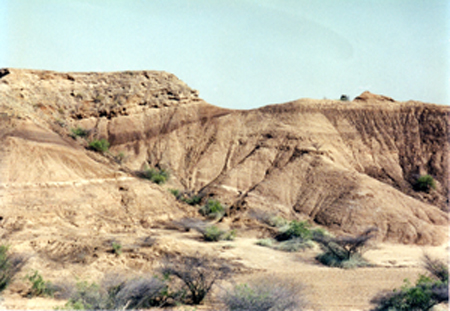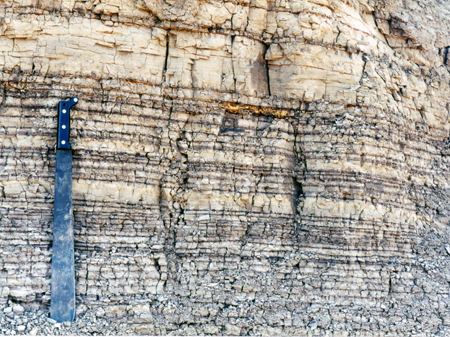Geotimes

Untitled Document

Web Extra
Monday, Feb. 28, 2005
Correction:
The 160,000 year date is not for the Omo I and II specimens. The age
instead comes from separate fossils found in Herto, Ethiopia.
Redating
the earliest humans
In 1967, anthropologist Richard Leakey and a team of fossil hunters found the
skulls and other remains of two humans, originally dated to 130,000 years ago
and classified as Homo sapiens, in the Omo Valley of Ethiopia. Now 40
years later, researchers have pushed back the ages of these earliest-dated modern
humans to 195,000 years ago.
This redating is not the first time scientists have taken another look at the
ages of the two specimens, Omo I and Omo II. In 2003, a separate study revamped
their date to approximately 160,000 * years ago, but
new dating techniques and the inclusion of new sedimentological data have added
another 30,000 years to their age, as published in the Feb. 17 Nature.
 "This kind of work helps people
understand how science works," says Richard Potts, director of Human Origins
with the Smithsonian Institution, who was not involved in the study. "People
think it's all driven by discovery, but we've known about these finds for a
while and it's the evaluation of the original site that is interesting here."
"This kind of work helps people
understand how science works," says Richard Potts, director of Human Origins
with the Smithsonian Institution, who was not involved in the study. "People
think it's all driven by discovery, but we've known about these finds for a
while and it's the evaluation of the original site that is interesting here."
The white band at the center of the left
side of the photo indicates the layer of tuff within the Kibish formation in
the Omo Valley of Ethiopia, where Omo I and Omo II were found. Image courtesy
of Frank Brown.
The original date was based on thorium and uranium isotopes of a mollusk shell
found with Omo I and II. The new study, however, used argon isotopic dating
on feldspar crystals found in pumice clasts from the volcanic layers above and
below the bones, which provided a range of dates for the fossils.
"Thorium/Uranium dating in the 1960s was not as reliable as current dating
methods," says Frank Brown of the University of Utah at Salt Lake City,
and co-author on the study. The argon method "can now date things we couldn't
touch in the 1960s."
 Brown, who was working with a separate
expedition in Ethiopia in 1967 when Omo I and II were found, returned with his
colleagues to the original excavation sites. Although the original researchers
incorrectly identified the location of Omo II in the literature, Brown says
that he and colleagues were able to use a series of photos from K. Butzer and
a hand-drawn map from Paul Abell, to return to the precise spot of the fossil
find. "We knew when we were at the site because we could hear it,"
Brown says. "Pumice makes a very distinctive sound under your feet —
it's the crunching of the glass."
Brown, who was working with a separate
expedition in Ethiopia in 1967 when Omo I and II were found, returned with his
colleagues to the original excavation sites. Although the original researchers
incorrectly identified the location of Omo II in the literature, Brown says
that he and colleagues were able to use a series of photos from K. Butzer and
a hand-drawn map from Paul Abell, to return to the precise spot of the fossil
find. "We knew when we were at the site because we could hear it,"
Brown says. "Pumice makes a very distinctive sound under your feet —
it's the crunching of the glass."
These centimeter-thick laminations represent
annual flooding for the Nile River, deposited in about 1,000 years. The machete,
for scale, is 60 cm long. Photo courtesy of Frank Brown.
The volcanic layers provided the age limits for the specimens, but within this
range were centimeter-thick laminations composed of ooze from organic remains
that decayed in an oxygen-free environment. Called sapropels, these small laminations
contain monsoon deposits from the Nile to the Mediterranean that record a 20,000-year
cycle. The wobble of Earth's axis, which controls the climate cycle between
wet and dry years, can thus predict the age of the sapropels, Potts says.
"This is the first study to couple well-dated climate cycles and Argon/Argon
dating," Potts says. Using this correlation, the authors give Omo I and
II a new age of 195,000 +/- 5,000 years old.
Although both specimens were found in relatively close proximity to one another,
much of the dating debate has been over the fact that Omo II "looks a little
more archaic in its features," Potts says. The next step then is to find
more samples to determine the variation in human populations at that time, he
says. "We know these specimens were from the same geologic layer, but do
we know if here was more than one population? Were they living together? The
only way to know is to get more."
For Brown, the next step is to spend more time understanding the sapropel correlation.
"I think we can correlate a lot of things…with astronomically controlled
climate changes," Brown says. For example, there is a 750,000-year-old
tuff layer at Kibish, but no corresponding sapropel. "If we don't see a
one-to-one correlation — and we don't — there's a reason. It's always
the pieces that don't fit that give you the most information," Brown says.
Laura Stafford
Back to top
Untitled Document

 "This kind of work helps people
understand how science works," says Richard Potts, director of Human Origins
with the Smithsonian Institution, who was not involved in the study. "People
think it's all driven by discovery, but we've known about these finds for a
while and it's the evaluation of the original site that is interesting here."
"This kind of work helps people
understand how science works," says Richard Potts, director of Human Origins
with the Smithsonian Institution, who was not involved in the study. "People
think it's all driven by discovery, but we've known about these finds for a
while and it's the evaluation of the original site that is interesting here."
